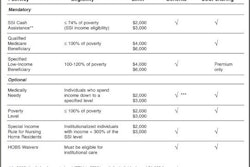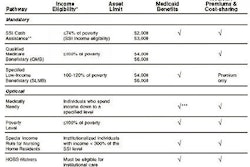Radiology advocates are planning a last-ditch effort to derail legislation passed in the U.S. Congress this week that would cut billions of dollars in payments for imaging services under the Medicare and Medicaid programs.
The cuts were made as part of the Deficit Reduction Act of 2005, which passed the Senate on December 21 in a 51-50 vote so close it required Vice President Dick Cheney to cast the deciding ballot. The House of Representatives has already passed a version of the bill, but the House and Senate versions differ slightly so the legislation will require another House vote before it becomes law.
The bill includes several provisions that are potentially damaging to the radiology community, according to Josh Cooper, senior director of government relations for the American College of Radiology (ACR) in Reston, VA. Some of the provisions had been expected, but others came out of the blue and could have potentially serious ripple effects on radiology, he said.
What was expected were cuts to Medicare payments for imaging studies of contiguous body parts taken in the same imaging session in physician offices. The Centers for Medicare and Medicaid Services (CMS) had already proposed making the cuts under the logic that imaging providers enjoy efficiencies when conducting such studies that should be reflected by a lower reimbursement rate.
The agency had suggested a 25% reduction in 2006 for Medicare payments for MR, CT, and ultrasound studies of contiguous body parts, and another 25% reduction in 2007. Congress agreed by putting the proposals in the deficit-reduction bill.
What wasn't expected, however, was an across-the-board cut to in-office imaging services that will slash at least $2.8 billion in Medicare payments over five years starting in 2007. The new legislation caps the technical component for physician office imaging to the lesser of the Hospital Outpatient Prospective Payment System (HOPPS) fee or the Medicare Fee Schedule, a figure that is less than the previous formula used to determine payments for physician office imaging, Cooper said.
The ACR estimates that the payment cuts will vary by imaging procedure, with some procedures seeing payment cuts as small as 3% while others are slashed by as much as 70%.
Cooper believes that the legislation may have been a reaction on the part of Congress to the recent debate over rising utilization of imaging services. Radiology advocates have laid the blame for rising imaging costs on physicians like cardiologists and orthopedic surgeons who are installing imaging equipment in their own offices and are self-referring patients.
"I think it was a very simplistic approach," Cooper said of the Congressional action. "It was also Congress in a very political and budget-cutting mode, not giving any thought to the ramifications of policy, just purely savings."
At first glance, the new legislation will affect radiologists and nonradiologists equally by capping payments for both groups. But nonradiologist physicians will be able to compensate for lower payments by increasing their volume of imaging studies, while radiologists will be unable to do the same as they don't control patient referrals, Cooper said.
What would be the long-term impact of the legislation? Cooper believes that it will negatively affect the quality of care in the Medicare system by making it less likely that subspecialty radiologists will accept new Medicare patients. It could also drive radiologists operating office-based practices -- such as those in rural facilities -- to move back to the hospital environment. And finally, the bill could lead to lower payments for imaging from private insurers, many of which base their payments on Medicare rates.
The ACR also believes that radiology is unfairly being forced to shoulder the burden of a $7.3 billion increase in Medicare funding for physician payments included in the legislation as part of an effort to eliminate what would have been a 4.4% cut to doctors scheduled to go into effect in 2006. The cut was called for under a formula used to calculate physician payments. By cutting imaging services by the $2.8 billion amount, radiology is being forced to shoulder more than one-third of the cuts required to offset the physician-payment increase.
The ACR is planning a major member outreach and lobbying plan to fight the legislation. The House still must vote on a version of the bill that reconciles the different House and Senate versions; Cooper believes that may not happen until January as the House has recessed for its holiday break.
"The ACR will be working diligently to repeal this and/or severely mitigate its effects," Cooper said.
By Brian Casey
AuntMinnie.com staff writer
December 22, 2005
Related Reading
Budget bill makes Medicare payment changes, December 21, 2005
NEMA takes aim at Medicare imaging payment cuts, December 20, 2005
CMS delays, reduces proposed Medicare imaging cuts, November 4, 2005
ACR questions proposed Medicare imaging pay cuts, July 27, 2005
Cost of reversing Medicare physician fee cut rises, July 22, 2005
Copyright © 2005 AuntMinnie.com



















